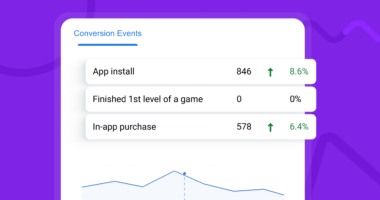Google Analytics is a great tool for digital marketing. Especially for website optimization. But sometimes, it just isn’t enough. In what cases Voluum can be the perfect alternative to Google Analytics? Let’s look at the differences between those two and see which tool is better for what.
Why is digital marketing so powerful? Because you can analyze almost every aspect of it. With all this data, you can optimize your strategy, so you get more visits, clicks, and conversions for less effort and money. It’s cheaper than traditional, offline advertising from the very beginning and, with proper optimization, can cost you even less.
Keeping “cheap” in mind as a baseline, there’s a lot of powerful and free tools for different aspects of your marketing. Google Analytics seems to be the go-to for analytics and optimization. At its core, Voluum does pretty much the same thing, you might think.
Well, it doesn’t. Although in some cases, Voluum intersects with GA’s functionality, we’re different in various cases. So, what are those? Which tool is better for which business case?
Read on to find out.
What Is Google Analytics for?
To get the overall difference, it’s best to start with the purpose of each tool.
Google Analytics is meant for analytics and optimization of the website that you own. While using it, you’ll get a better understanding of your users’ behavior. You’ll also get insights into the acquisition part. Where are your users coming from? What are the traffic sources? What do typical users do on your page? These are questions that can be answered by Google Analytics.
So, is Voluum purpose any different?
In short, yes. Voluum is designed to support paid advertising extensively. It’s more about managing the traffic. Let’s put it this way: if Google Analytics is about optimizing your website for the traffic that comes to it, Voluum is about optimizing the traffic itself to match your landing pages or the offers you promote.
[sc name=”summer_promo_1″]
Voluum is also oriented on the ROI of your campaigns, while Google Analytics is more focused on optimizing the website’s performance and user experience. Of course, you can integrate GA with AdWords or DoubleClick and get basic metrics coming from these ad networks, but it takes more experience, knowledge, and time to set it up.
But, let’s dig a little deeper.
Google Analytics and Voluum. How Do They Work?
There’s a big difference already in the setup and the technology behind these two platforms. Voluum tracking is based on redirects. This means that when someone clicks a link, it first goes through one of Voluum’s data centers and then to the intended destination. All the tracking happens during that couple of milliseconds when the user is going through our servers.
Google’s technology is based on JavaScript code that needs to be put in the header of every website you would like to track. In this case, all the tracking is triggered when a user loads the page, and the data is sent to Google Analytics straight away using that code.
There are, of course, some pros and cons to both approaches. The redirects let you track the traffic between the click and the page being loaded, so you can track external websites as well. This method is often used by agencies and performance marketers that promote offers that don’t belong to them.
[sc name=”webinar_promo_2″]
The setup of a redirect-based analytics tool is, to some extent, easier. You just have to create an account, generate tracking links, so they pass along all the information about users and conversions correctly. Without any additional setup, this kind of tracking won’t tell you, however, how much time was spent on the page, what the bounce rate is and so on—but with the tracking pixel or postback URLs, you’ll get all the info about conversions made on the page.
Google Analytics can be set up almost only on the websites you own. You need to have access to the source code to make it work. The basic setup of GA doesn’t require too much technical knowledge. You just paste the generated code in the right place and that’s it. But if you want to track the conversions and understand various traffic sources, it gets harder. Not that it’s impossible, but you’ll need a developer or will need to know how to use Google Tag Manager to set all the events correctly.
All the cookie-based third party tools that are implemented in the source code are vulnerable to blocking by AdBlock, Disconnect, and the like. Because of that, several percent of visits might be invisible to GA. The redirects are more precise in this matter.
But this isn’t the whole story. To discover it, let’s break this down to the functionality.
Tracking Across Multiple Domains
Google Analytics is designed to get you a very detailed set of statistics about your website’s performance. With cross-domain tracking, it can also monitor users’ behavior on multiple domains, but that requires some GA skills.
In Voluum, on the other hand, you’ll get a view across all your campaigns, linked to various domains, from the very beginning. The main purpose of our reports is to show how these campaigns are doing in various places, what users find them attractive, and what their ROI is.
Tracking Conversions
As we mentioned before, Google Analytics can track conversions. For example, if it’s set up on an e-commerce website, you’ll be able to track users who purchase products, add them to their shopping carts, and so on. To do all this, however, you need a specific setup that requires digging into the code.
Voluum can also track these, even on external websites—as long as they pass this info back to our platform. They’ll do that with a correct setup of the tracking URL—it needs to carry the info about the conversion. If this is done, you won’t only see the conversions for one e-commerce site—you’ll see them for all the businesses you work with!
But then there’s the LTV tracking, which allows you to keep the track of clients’ lifetime value. With our custom conversion tracking, you can track not only the first purchase, but all the consecutive ones as well. Based on that, you can optimize to find groups of clients who bring in more value in the long term. This feature is important to all the app owners and affiliates promoting similar offers. If they get a commission on every purchase, they’ll be able to track it.
Tracking Costs and Revenue
Again, if Voluum is set up right with your partners, it will also track the costs and profits – on the traffic source side, as well as for the commissions that you might get when promoting third-party offers. For business owners, Voluum can also track the profit they make on every purchase. Based on this, Voluum will calculate the Return On Investment of your campaigns, to expose the campaigns that perform the best.
GA can also track costs and revenue. You can even set up different attribution models to see what actions leading to the purchase are the most important. You’ll set up the cost of acquisition in various models and see how much you will get in return. You can even integrate GA with AdWords or DoubleClick to get real-time data on the cost of acquisition. Unfortunately, all this requires a lot of experience to set it up accurately—but it’s possible.
Personalization
We, digital marketers, know that proper targeting is often the key to success. Some traffic sources, such as Facebook and Google AdWords, allow us to do that extensively. Some of them are pre-targeted by the audience that they’ve already gathered. Some are not targeted at all but are cheap and with a broad reach.
How do you navigate in such a world? You need to test and optimize. Voluum helps you with that on many levels. The most powerful feature for that are rule-based paths. Within those, you can set countless rules to divide your traffic and redirect it where it will find the content that is most relevant—and give you the most in return.
For example, you can say that all users clicking the banner from China will see a landing page in Chinese, with a special offer for jeans. The same campaign could lead people from the USA to a page in English, with leather jackets. All this can happen within one traffic source. Such personalization should bring you higher conversion rates—and can be set for a very detailed set of rules in less time than creating separate campaigns for each target group.
This way, although you can’t target within the traffic source itself, you can try to match your landing pages and offers to the traffic source.
Google Analytics won’t let you optimize the traffic itself, but can team up with Google Optimize to show personalized content on the landing page. As it’s meant for A/B testing the pages, it can alter the looks and the texts based on a set of rules, but for the free version, it’s only easy if you do that with Google AdWords. Google Optimize can also redirect users once they land on the page, although this functionality is harder to use on traffic acquired outside the Google ecosystem, such as traffic from Facebook. I won’t say you can’t do it, but it’s not so easy.
This difference comes out of the technology behind these two solutions. While Voluum redirects the user through its own servers, so it can redirect anywhere in the Internet, Google can only make changes to the website once its script is triggered. That means it will only apply them once you’re already on the landing page.
Further Optimization
So, you can personalize the content and user experience. But how to make it work even better for you? With A/B testing, of course.
Both Voluum and Google Analytics can do that, in one way or another. Voluum, however, lets you automate the A/B testing. You can just put a set of offers into the flow of the campaign, and the best distribution possible will be applied automatically by the Voluum AI.
Which to Use and When?
Google Analytics still feels kind of similar to Voluum, right? Don’t worry, that’s why there’s so much misunderstanding between those two platforms in the first place. It’s all about how you want to support your business with your tools.
Using Voluum makes more sense if you do lots of paid advertising campaigns, across many ad platforms. Join that with lots of different landing pages, offers, and, if you still want to have control over your performance—Voluum is the place to go. It’s also more ROI-oriented, so you can get the most out of your advertising budget. And you don’t have to be a programmer to set it up!
Google Analytics, on the other hand, is still very useful for extensive organic traffic and optimizing your web pages. It will let you understand where traffic is coming from and how to create the best experience for your audience to reach your goals.
Need more information about the differences between these two? Let’s have a conversation in the comments section!
Key takeaways:
- Google Analytics and Voluum are quite similar platforms;
- Voluum tracking happens while the user is redirected, Google Analytics tracks once the user loads a website;
- Voluum lets you optimize broad paid advertising better;
- Google Analytics lets you optimize websites;
- You can use both platforms for the same use cases, but tracking ads in multiple traffic sources requires more advanced skills in GA.
- To define which tool is better for you, you need to understand what’s your business case.






3 comments
hello!! Thanks for this. I agree with you that google analytics is the best tool for digital marketing. While there is no shortage of data flowing into your business, getting the most out it can be challenging. The Google Analytics EULA does not allow you to track individual users by identifying them. So if you wanted to add a custom variable for the username to track how many times each user logs in, then you would be in a gray zone if not outright violating the EULA.Thanks for reading this…
Thanks! It’s possible to accomplish a lot with GA but at some point, it requires quite some effort.
Thank you very much for sharing.